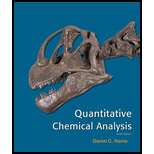
Quantitative Chemical Analysis
9th Edition
ISBN: 9781464135385
Author: Daniel C. Harris
Publisher: W. H. Freeman
expand_more
expand_more
format_list_bulleted
Concept explainers
Question
Chapter 20, Problem 20.24P
Interpretation Introduction
Interpretation:
The total reflection is occurs and the minimum refractive index of the prism for total reflection has to be explained.
Concept introduction:
Snell’s law:
The angle of incidence is equal to the angle of reflection by the light is reflected.
Expert Solution & Answer
Want to see the full answer?
Check out a sample textbook solution
Students have asked these similar questions
For a reaction to be spontaneous, the Gibbs Free Energy must be less than zero.
True or False
Which of the following reactions will be exothermic?
a) Reaction has enthalpy less than zero.
b) Reaction has enthalpy greater than zero.
c) Reaction has entropy less than zero.
d) Reaction has entropy equal to zero.
How many valence electrons are used in predicting the Lewis Dot structure of CH4?
a) 8
b) 6
c) 10
d) 2
Chapter 20 Solutions
Quantitative Chemical Analysis
Ch. 20.2 - Prob. 1TYCh. 20.4 - Prob. 2TYCh. 20 - Prob. 20.AECh. 20 - Prob. 20.BECh. 20 - Prob. 20.CECh. 20 - Prob. 20.DECh. 20 - Prob. 20.1PCh. 20 - Prob. 20.2PCh. 20 - Prob. 20.3PCh. 20 - Prob. 20.4P
Ch. 20 - Prob. 20.5PCh. 20 - Prob. 20.6PCh. 20 - Prob. 20.7PCh. 20 - Prob. 20.8PCh. 20 - Prob. 20.9PCh. 20 - Prob. 20.10PCh. 20 - Prob. 20.11PCh. 20 - Prob. 20.12PCh. 20 - Prob. 20.13PCh. 20 - Prob. 20.14PCh. 20 - Prob. 20.15PCh. 20 - Prob. 20.16PCh. 20 - Prob. 20.17PCh. 20 - Prob. 20.18PCh. 20 - Prob. 20.19PCh. 20 - Prob. 20.20PCh. 20 - Prob. 20.21PCh. 20 - Prob. 20.22PCh. 20 - Prob. 20.23PCh. 20 - Prob. 20.24PCh. 20 - Prob. 20.25PCh. 20 - Prob. 20.26PCh. 20 - Prob. 20.27PCh. 20 - Prob. 20.28PCh. 20 - Prob. 20.29PCh. 20 - Prob. 20.30PCh. 20 - Prob. 20.31PCh. 20 - Prob. 20.32PCh. 20 - Prob. 20.33PCh. 20 - Prob. 20.34PCh. 20 - Prob. 20.35P
Knowledge Booster
Learn more about
Need a deep-dive on the concept behind this application? Look no further. Learn more about this topic, chemistry and related others by exploring similar questions and additional content below.Similar questions
- How many valence electrons are used in predicting the Lewis Dot structure of CO2? a) 32 b) 26 c) 24 d) 16arrow_forwardHow many valence electrons are used in predicting the Lewis Dot structure of NO2? a) 17 b) 12 c) 5 d) 10arrow_forwardA compound that is bonded with an ionic bond is unlikely to dissolve in water. True or Falsearrow_forward
- In VSEPR Theory, AX6 is a) linear b) tetrahedral c) octahedral d) trigonal bipyramidarrow_forwardElectronegativity is the ability of an atom to attract an electron pair needed for covalent bonding. True or Falsearrow_forwardA single bond is called a) sigma bond b) pi bond c) hybrid bond d) hydrogen bondarrow_forward
- Predict the major organic products of the reaction below and draw them on right side of the arrow. If there will be no significant reaction, check the box below the drawing area instead. 田 m D H Cl H H There will be no significant reaction. + G હે Click and drag to start drawing a structure.arrow_forwardBased on the definitions for different types of bonding, which of these compounds should have the highest melting point? a) NaCl b) O2 c) CH4 d) N2arrow_forwardWhich of these compounds is held together by covalent bonding? a) CCl4 b) NaCl c) FeCl3 d) KBrarrow_forward
- In VSEPR Theory, AX4 is a) linear b) tetrahedral c) octahedral d) trigonal bipyramidarrow_forwardValence electrons a) form covalent bonds & are in the outer electronic shell b) form covalent bonds & are in the inner electronic shell c) hold ions together by electrostatic interaction d) are generally weaker than other bondingarrow_forward4 W X D de % F5 人 :0: > F6 1. Fill in the missing information 2. Na2Cr207 H2SO4, H20 OEt H₂O+ SOC2 CI SOCI C DELL OH 480 NEOH F7 B. F8 prt sc home end insert F9 F10 F11 F12 & * + VIX -4.arrow_forward
arrow_back_ios
SEE MORE QUESTIONS
arrow_forward_ios
Recommended textbooks for you
 ChemistryChemistryISBN:9781305957404Author:Steven S. Zumdahl, Susan A. Zumdahl, Donald J. DeCostePublisher:Cengage Learning
ChemistryChemistryISBN:9781305957404Author:Steven S. Zumdahl, Susan A. Zumdahl, Donald J. DeCostePublisher:Cengage Learning ChemistryChemistryISBN:9781259911156Author:Raymond Chang Dr., Jason Overby ProfessorPublisher:McGraw-Hill Education
ChemistryChemistryISBN:9781259911156Author:Raymond Chang Dr., Jason Overby ProfessorPublisher:McGraw-Hill Education Principles of Instrumental AnalysisChemistryISBN:9781305577213Author:Douglas A. Skoog, F. James Holler, Stanley R. CrouchPublisher:Cengage Learning
Principles of Instrumental AnalysisChemistryISBN:9781305577213Author:Douglas A. Skoog, F. James Holler, Stanley R. CrouchPublisher:Cengage Learning Organic ChemistryChemistryISBN:9780078021558Author:Janice Gorzynski Smith Dr.Publisher:McGraw-Hill Education
Organic ChemistryChemistryISBN:9780078021558Author:Janice Gorzynski Smith Dr.Publisher:McGraw-Hill Education Chemistry: Principles and ReactionsChemistryISBN:9781305079373Author:William L. Masterton, Cecile N. HurleyPublisher:Cengage Learning
Chemistry: Principles and ReactionsChemistryISBN:9781305079373Author:William L. Masterton, Cecile N. HurleyPublisher:Cengage Learning Elementary Principles of Chemical Processes, Bind...ChemistryISBN:9781118431221Author:Richard M. Felder, Ronald W. Rousseau, Lisa G. BullardPublisher:WILEY
Elementary Principles of Chemical Processes, Bind...ChemistryISBN:9781118431221Author:Richard M. Felder, Ronald W. Rousseau, Lisa G. BullardPublisher:WILEY

Chemistry
Chemistry
ISBN:9781305957404
Author:Steven S. Zumdahl, Susan A. Zumdahl, Donald J. DeCoste
Publisher:Cengage Learning

Chemistry
Chemistry
ISBN:9781259911156
Author:Raymond Chang Dr., Jason Overby Professor
Publisher:McGraw-Hill Education

Principles of Instrumental Analysis
Chemistry
ISBN:9781305577213
Author:Douglas A. Skoog, F. James Holler, Stanley R. Crouch
Publisher:Cengage Learning

Organic Chemistry
Chemistry
ISBN:9780078021558
Author:Janice Gorzynski Smith Dr.
Publisher:McGraw-Hill Education

Chemistry: Principles and Reactions
Chemistry
ISBN:9781305079373
Author:William L. Masterton, Cecile N. Hurley
Publisher:Cengage Learning

Elementary Principles of Chemical Processes, Bind...
Chemistry
ISBN:9781118431221
Author:Richard M. Felder, Ronald W. Rousseau, Lisa G. Bullard
Publisher:WILEY
Molecular spectroscopy; Author: Vidya-mitra;https://www.youtube.com/watch?v=G6HjLIWvCQo;License: Standard YouTube License, CC-BY